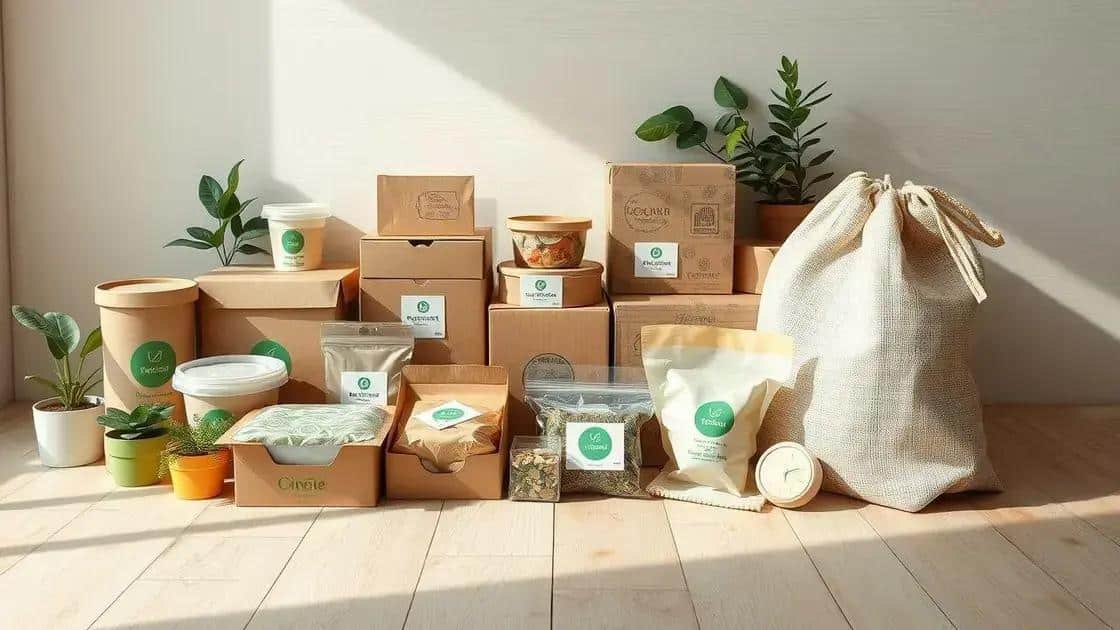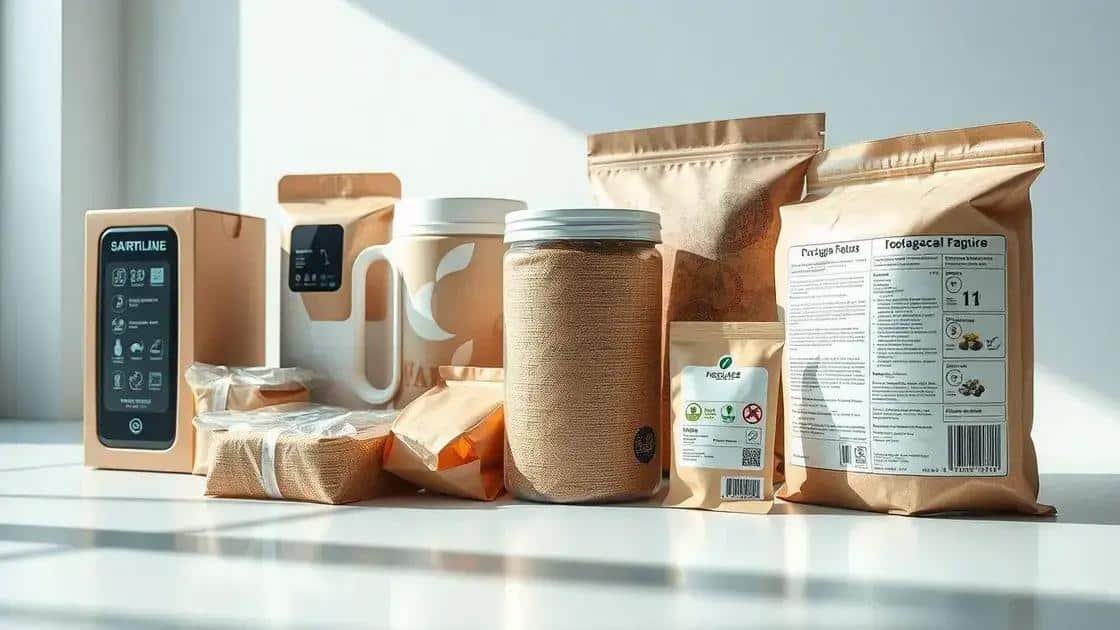Sustainable packaging news trends: What you need to know

Sustainable packaging news trends emphasize eco-friendly materials and innovative designs, driving brands to adopt practices that minimize environmental impact while enhancing consumer engagement and transparency.
In today’s world, sustainable packaging news trends are more important than ever. As consumers become increasingly eco-conscious, businesses are adapting by innovating their packaging solutions. Curious about how this impacts you and your choices? Let’s explore!
Current trends in sustainable packaging
The world of sustainable packaging is evolving rapidly. Today, businesses are increasingly adopting eco-friendly practices, reshaping how products are packaged and delivered. Understanding current trends in sustainable packaging can help consumers make informed choices that benefit both the environment and their purchasing decisions.
Innovative Materials
New materials are at the forefront of the sustainable packaging movement. Companies are experimenting with biodegradable options that break down naturally, reducing waste. Some brands are even introducing packaging made from recycled materials, which help lower the carbon footprint.
Consumer Preferences
Today’s shoppers are more conscious of their environmental impact. They actively seek products with sustainable packaging. This shift in consumer behavior encourages brands to adopt green practices, aligning their goals with the values of their customers.
- Biodegradable plastics from plant materials
- Recycled cardboard and paper products
- Reusable packaging options
- Minimalist packaging designs
As more companies go green, the market for sustainable packaging grows. Brands that prioritize sustainability not only attract eco-conscious consumers but also set a standard for industry practices. This creates a positive cycle where the demand for eco-friendly products fuels further innovation.
In addition to materials, the design of packaging is evolving. Many brands are opting for minimalist packaging that emphasizes simplicity and reduces the amount of material used. This trend not only appeals to consumers but also resonates with efforts to minimize waste.
Regulatory Changes
Governments worldwide are implementing regulations that encourage sustainable practices. These changes create pressure for businesses to enhance their packaging strategies. Companies that adapt quickly position themselves as leaders in the marketplace, gaining a competitive edge.
Ultimately, the rise of sustainable packaging trends signals a shift towards a more responsible future. As awareness grows and technology improves, these trends will continue to shape how products are packaged and how consumers choose to engage with brands.
Materials transforming the packaging industry

The packaging industry is experiencing a significant transformation thanks to innovative materials. These advancements are not only improving product safety but are also promoting sustainability and reducing environmental impacts. Businesses are increasingly seeking alternatives that align with sustainable practices.
Biodegradable Plastics
One of the most exciting developments is the rise of biodegradable plastics. These materials break down more easily in the environment compared to traditional plastics. Made from natural sources like corn starch, they offer a promising alternative that reduces landfill waste.
Recycled Materials
Another important trend is the use of recycled materials. Packaging made from post-consumer waste not only decreases the demand for new resources but also supports a circular economy. Companies are now using recycled paper, plastic, and even glass to create new packaging solutions.
- Recycled cardboard for shipping boxes
- Plastic films derived from recycled bottles
- Glass containers made from recycled glass
As businesses adopt these materials, they are also highlighting their commitments to sustainability. Consumers appreciate brands that take steps to protect the environment, which drives demand for such innovations.
Another fascinating development is the use of plant-based materials. These include new types of packaging made from hemp, seaweed, and other organic materials. These options provide natural alternatives that are both safe for the environment and effective for product protection.
Smart Packaging
The advent of smart packaging is changing how products are presented and consumed. This technology often includes features like freshness indicators or QR codes that engage consumers and provide additional information about the product’s origin and lifespan. This not only enhances user experience but also promotes sustainable choices.
In summary, the materials transforming the packaging industry are reshaping our relationship with products. With each innovative step, companies are becoming more responsible, allowing consumers to make better choices and contribute to a greener planet.
How brands are embracing sustainability
Many brands today are actively embracing sustainability as a core part of their business strategies. This shift is not just a trend; it reflects a growing recognition of the importance of protecting our environment while meeting consumer demands. By adopting sustainable practices, brands can enhance their image and connect better with eco-conscious customers.
Commitment to Green Practices
Companies are investing in eco-friendly technologies and methods to reduce their environmental impact. Many are focusing on their supply chains to ensure they are as sustainable as possible. This commitment often includes sourcing raw materials responsibly and reducing waste throughout production.
Transparency and Reporting
Another way brands are showing their commitment to sustainability is through transparency. More companies are publishing sustainability reports that outline their goals, progress, and future plans. This practice not only builds trust but also allows consumers to hold brands accountable.
- Detailed reports on carbon emissions
- Information about sustainable sourcing
- Plans for reducing water usage
- Efforts in waste management
Many brands are also shifting to sustainable packaging to minimize their environmental footprint. This includes using recyclable, biodegradable, and compostable materials for their products. By doing this, they aim to reduce plastic waste and promote a circular economy.
Furthermore, brands are engaging customers through educational campaigns centered on sustainability. They might use social media to share tips on recycling or host events that promote environmental awareness. This not only informs consumers but also helps build a community focused on sustainable living.
Collaboration with Organizations
Some brands are partnering with environmental organizations to enhance their sustainability efforts. These collaborations can lead to more effective initiatives and research that promotes greener practices within industries. By working together, brands can create significant changes and showcase their dedication to the planet.
In today’s market, consumers favor brands that take sustainability seriously. By recognizing and adapting to this shift, companies can enhance their credibility and attract a loyal customer base. Ultimately, brands embracing sustainability are paving the way for a more responsible future.
The future of packaging: What to expect

The future of packaging looks promising as innovators are constantly finding new ways to make it more sustainable and efficient. With ongoing changes in technology and consumer preferences, packaging will continue to evolve. It is crucial for businesses to stay ahead of these trends to meet the demands of environmentally conscious consumers.
Smart and Interactive Packaging
One significant trend is the rise of smart packaging. This technology allows packaging to communicate with consumers. For example, smart labels can provide information about the product’s freshness. They can also include QR codes that link to additional content, engaging consumers in new ways.
More Sustainable Options
As sustainability becomes a priority for consumers, brands are expected to adopt even more eco-friendly materials. This includes using materials that are biodegradable or come from renewable resources. Companies are exploring new inventions such as packaging made from mycelium or seaweed, which are both strong and environmentally safe.
- Biodegradable films derived from plants
- Packaging that can be recycled multiple times
- Edible packaging for food products
Another aspect of the future of packaging is the emphasis on minimalism. Simple designs not only appeal visually but also reduce the volume of materials used. This not only cuts costs for manufacturers but also decreases waste for consumers.
Brands are likely to continue prioritizing transparency in their packaging. This means providing clear information about how to dispose of the packaging correctly. By educating consumers about waste management, brands can encourage responsible behaviors.
Regulatory Changes and Innovations
As governments push for stricter regulations on waste and plastic usage, businesses will need to adapt quickly. This could lead to more innovations in packaging design as companies look for ways to comply with new laws while remaining appealing to consumers. The regulatory landscape will play a significant role in shaping the future of packaging.
In summary, the future of packaging holds many exciting possibilities. From adopting smart technologies to enhancing sustainability, brands are poised to transform how products are packaged and consumed. Staying aligned with these trends will be essential for success in the evolving market.
In conclusion, the packaging industry is heading towards a more sustainable and innovative future. Brands are embracing new materials and technologies that reduce waste and enhance consumer experience. As awareness about environmental issues grows, both companies and consumers play essential roles in supporting sustainable practices. By choosing eco-friendly packaging and supporting brands that prioritize sustainability, we can all contribute to a healthier planet. The future of packaging not only promises advancements in efficiency but also fosters a greater connection between products and the environment.
FAQ – Frequently Asked Questions about Sustainable Packaging
What is sustainable packaging?
Sustainable packaging refers to eco-friendly solutions that minimize environmental impact, such as using biodegradable or recyclable materials.
How can consumers support sustainable brands?
Consumers can support sustainable brands by choosing products that use eco-friendly packaging and by engaging with brands that prioritize sustainability.
What are some innovative materials in sustainable packaging?
Innovative materials include biodegradable plastics, recycled paper products, and plant-based packaging that are designed to reduce waste.
Why is transparency important for brands?
Transparency helps build trust with consumers, as brands that share their sustainability efforts and practices are more likely to gain customer loyalty.





